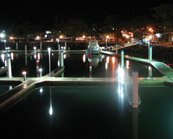Offshore: Gear must stand up to rough conditions for long periods without failing while keeping you dry and comfortable.
Inshore: Gear must have the same features as offshore but needn’t be as rugged, because of your more limited exposure to rough weather conditions.
Racing: One design and club racing can be very wet with a lot of exertion for short periods. The emphasis is on light weight, comfort, flexibility and keeping dry. It’s hard to be effective if you’re cold and wet.
Dayboating: Gear is designed for casual wear inshore in sheltered waters. There may be occasional rain, wind and spray for a short time.
Fishing: Fishing can be messy, and you’ll need to be hosed off. Welded-seam PVC gear can be hosed down and resists staining, but it doesn’t breathe.
Regardless of where you boat, staying dry and comfortable is key. Keep water out and get rid of the moisture you generate. Let’s look at some fashions for foul weather.
1. Breathable is the way to go. Better foulies use microporous material such as Gore-Tex. Water vapor and sweat escape, while water cannot enter. Other breathable gear uses hydrophilic fabric. Your body heat and the high moisture concentration inside the gear force vapor out to cooler, lower-moisture concentrations outside the gear. When you rest, your body cools and vapor transfer is less effective, which can leave you feeling cold and clammy.
2. Watertight pockets will keep things dry, but a simple flap fastened by Velcro isn’t enough. Pocket and flap material should fold over and then fasten. I’m a pessimist: Pockets also should have weep-holes. Fleece-lined hand-warmer pockets are nice and should be closable.
3. Zippers should be protected by inside and outside flaps. The inside flap should cover the zipper and fold over to form a tunnel, so water getting past the outside flap is channeled out.
4. Collars should be high, lined and adjustable to keep water out. Preferably, they should have a flap closure as well. Hoods should turn with your head, and cuffs should be watertight. Elasticized cuffs will allow water in if you lift your arms.
5. Jackets should have drawstrings on the bottom and at the waist to keep the wind out, and linings that are free at the bottom. All seams should be taped, and linings in sleeves (and legs) should be attached with mesh.
6. I prefer bibs to foul weather pants, even for inshore boating, because water always seems to get into pants. Bibs should have zippered fronts protected by a deep gusset that makes it easy to heed nature’s call. Women’s bibs should have drop seats with watertight zippering for obvious reasons. Leg bottoms should cinch up to close over foul weather boots. I hate wet feet, so, being of the offshore persuasion, I like fairly tall boots.
7. I like bright-colored jackets. Red looks black in darkness, but fluorescent greens, electric blues and yellows show up at night and, God forbid, if you go over the side. Retro-reflective tape on hoods, shoulders and sleeves is a very good idea. Black, white or dark-blue foulies blend with the water if you’ve fallen overboard.
8. Brimmed hats make more sense than baseball caps, and nobody wears so’westers.
Article by: Michael Saylor
Soundings Publications LLC
SoundingsPub.com


